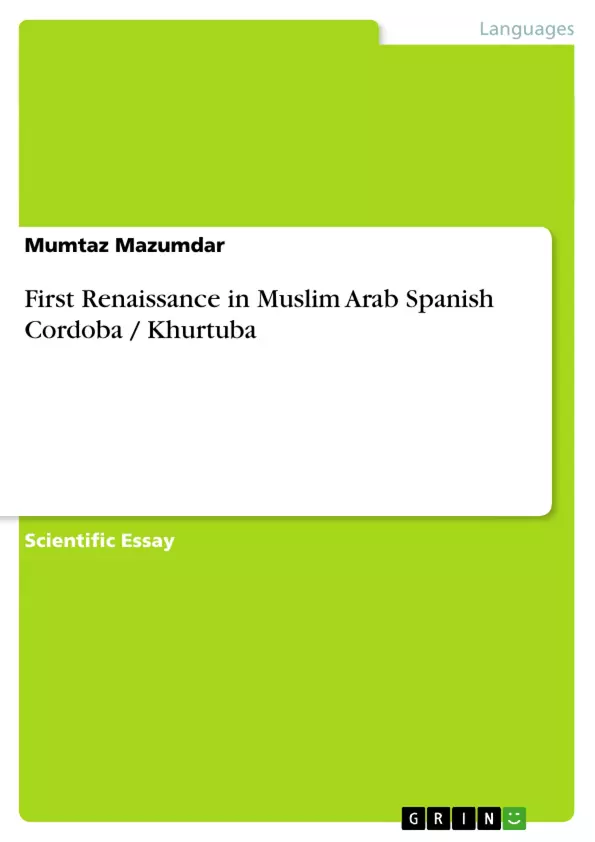Cordoba or Khurtuba is a city located in Andalusia in southern Spain, and is the capital of the province of Cordoba. It lies upon the river Guadalquivir. It has human history tracing back to the Neanderthal man of nearly 32000 BC. It was an Iberian and Roman city in the ancient times. In 206 BC it was conquered by the Romans and at its time of Julius Caesar, it was the capital of the Roman province of Hispania. From 552 to 572 BC, it occupied an important place in the Byzantine Empire. In the Middle Ages it became the capital of an Islamic caliphate. In 711 an Arab or Berber Muslim army captured it and soon in 716 it became a provincial capital in subordinate to the Caliphate of Damascus. By 766 it was made the capital of the Independent Arab Muslim emirate of al-Andalus which later became the Caliphate itself…. This city along with other Arab places actually gained the notice as beginner of Renaissance, the Renaissance which left the world changed forever! This essay deals with the introduction of Renaissance in Spanish Cordoba or Khurtuba
Inhaltsverzeichnis (Table of Contents)
- The Arab Conquest of Spain
- The Caliphate of Cordoba
- The Golden Age of Islamic History
- The Decline of Cordoba
- The Legacy of Cordoba
- The Arab Spring and the Call for Unity
Zielsetzung und Themenschwerpunkte (Objectives and Key Themes)
This text explores the historical and cultural significance of Cordoba, a city in Andalusia, Spain, and its role in the Islamic Golden Age. It examines the city's rise as a center of learning, trade, and intellectual innovation, highlighting its contributions to science, mathematics, medicine, and other fields. The text also analyzes the decline of Cordoba, emphasizing the loss of its cultural prominence and the impact of political instability. Finally, the text connects the historical experience of Cordoba to contemporary calls for pan-Islamic unity and the Arab Spring, arguing for the relevance of Cordoba's legacy in fostering a sense of Muslim identity and collective action.- The Islamic Golden Age and the role of Cordoba
- The rise and fall of the Umayyad Caliphate in Al-Andalus
- The contributions of Muslim scholars and intellectuals in Cordoba
- The impact of Cordoba's legacy on the European Renaissance
- The call for pan-Islamic unity and the Arab Spring
Zusammenfassung der Kapitel (Chapter Summaries)
This chapter outlines the historical background of Cordoba, tracing its origins to ancient times and its subsequent conquest by the Arabs in 711 AD. It explores the establishment of the Umayyad Caliphate in Cordoba and its expansion across North Africa and Hispania. The chapter further highlights the significance of the city as a cultural center under Islamic rule, showcasing its achievements in trade, technology, and scholarship.
This chapter delves into the remarkable flourishing of the Caliphate of Cordoba during the 10th and 11th centuries. It focuses on the city's architectural marvels, particularly the Great Mosque of Cordoba, and its emergence as the intellectual heart of Europe. The chapter also examines the city's vibrant economy, vast library, and bustling population.
This chapter explores the Golden Age of Islamic history, emphasizing the contributions of Muslim scholars and scientists during this period. It highlights Cordoba's role in promoting scientific knowledge, cultural arts, and architecture, particularly in the fields of mathematics, astronomy, and medicine. The chapter also discusses the impact of Cordoba's intellectual renaissance on Europe, challenging conventional narratives about the origins of the Renaissance.
This chapter examines the decline of Cordoba, starting with the fall of the Caliphate in 1031. It explores the subsequent political instability and the impact on Cordoba's economic and cultural prominence. The chapter also delves into the city's decline in the 18th century and its gradual resurgence in the 20th century.
This chapter examines the lasting legacy of Cordoba, arguing for its enduring influence on Islamic thought and culture. It highlights the city's role in inspiring contemporary calls for pan-Islamic unity and the Arab Spring, showcasing the relevance of Cordoba's model of intellectual and cultural flourishing.
This chapter analyzes the contemporary context of the Arab Spring and its connection to the legacy of Cordoba. It emphasizes the importance of pan-Islamic unity and the need to revive the ideals of scholarship and cultural advancement embodied in Cordoba's Golden Age. The chapter concludes by calling for Muslims around the world to draw inspiration from Cordoba's example and overcome the challenges of fear, failure, and inferiority.
Schlüsselwörter (Keywords)
The key concepts and themes that form the core of this text include: Islamic Golden Age, Cordoba, Umayyad Caliphate, Al-Andalus, science, mathematics, medicine, astronomy, architecture, Renaissance, Arab Spring, pan-Islamic unity, Muslim identity, collective action, cultural legacy, intellectual flourishing. This text explores the history and legacy of Cordoba, highlighting its contributions to knowledge and its role in fostering a sense of Muslim identity and solidarity. It examines the connections between Cordoba's past and the contemporary movements for pan-Islamic unity and the Arab Spring.- Citation du texte
- Mumtaz Mazumdar (Auteur), 2013, First Renaissance in Muslim Arab Spanish Cordoba / Khurtuba, Munich, GRIN Verlag, https://www.grin.com/document/209660



